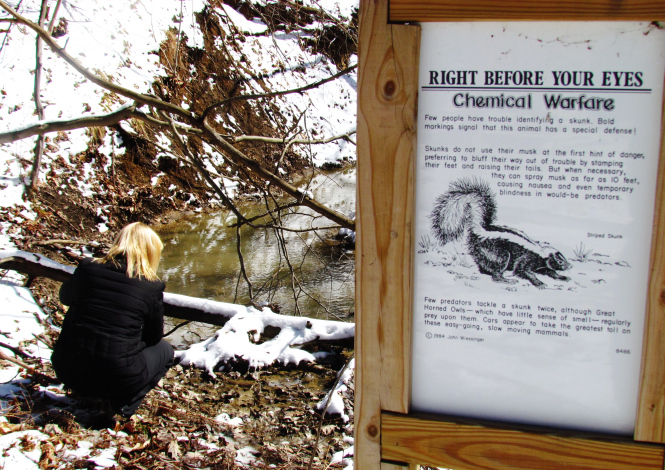The Wilder Side of Oakland County

A skunk captured under a deck in a live trap presents a removal challenge for the homeowner.
Courtship is well underway for Mephitis mephitis, the often maligned striped skunk, and that means the scent of love is in the night air. Romance for the skunk is a simple affair: wander about under the cover of darkness and search for a suitable mate. Yet, during these nocturnal searches, as winter slowly wanes, skunks may encounter other critters of the night: raccoons, coyotes, fox, cats and dogs. If these creatures do not give the hormonal-driven skunk, with a mission of mating on its mind, a wide berth, the skunk will swing into defensive mode. First comes a warning: the front paws pound up and down. Perhaps that message serves to say, “Do you remember me from last time?”

The great horned owls of Oakland County frequently prey on skunks.
Skunks are legendary for their powerful chemical warfare predator deterrent—a bitterly putrid smelling spray. The skunk, like the weasel and mink which are also found in Oakland County, are members of the Mustelid family. They all produce very strong smelling musk from a scent gland. However, only the skunk can fire the musk as mist. The skunk is an excellent marksman and when needing to defend itself from a threat, it will raise its furry tail, swing around and blast away from twin nipples hidden under the tail. The fine oily droplets can carry 10 feet and the smell persists for days on anything it touches. This defense works extremely well to ward off most predators. A notable exception would be that of the great horned owl, a significant predator of skunks in rural Oakland County. The defense fails miserably for fast approaching cars.

Skunk tracks are very noticeable in deep snow. Their low to the ground bodies often leave a “plowed” path.
Skunks have a natural preference for the abandoned dens of woodchucks, coyotes and fox. Many skunks set up housekeeping under large fallen logs or under rock piles. Much to the chagrin of humans, low to the ground patio decks and backyard sheds are five star hotels for a skunk seeking shelter. Their tracks and classic meandering trails in the snow indicate shopping for suitable real estate. The good news is that skunks are not aggressive toward humans. The bad news is that the presence of humans will not encourage them to leave and that’s where troubles begin.

Skunks often meander near creeks in the waning days of winter. This interpretive sign is at the Hawk Woods Nature Center in Auburn Hills.
If you, or your pets, get sprayed by a skunk, bathing in tomato juice to remove the chemical takes a lot of juice and is very questionable in its effectiveness. A tried and true formula consists of carefully mixing one liter of hydrogen peroxide with ¼ cup of baking soda and 1 teaspoon of dish washing liquid soap. Be sure not to get it in the eyes and do not seal the container when done as pressure can build up, causing it to explode. An internet search will give details on this formula and others.
The fine dining habits of skunks are in many ways beneficial to humans. Skunks eat mice, voles and almost any species of insect to be found in a garden. In a few months, when the snow is gone and the earth is warm and greening up, skunks will turn their attention to a delicacy we fear: underground yellow jacket nests. Perhaps we should look at the skunky scent in the air in these early nights of March as a signal that the dawn of spring is near.
Text and photos by Nature Education Writer Jonathan Schechter.
Visit www.oakgov.com/parks for details and maps on all 13 Oakland Parks and spring outdoor recreation opportunities. Originally published on March 6, 2015, updated on March 10, 2016.

[…] the night, it’s a protein rich and easy meal. A disturbed nesting site quickly attracts crows, skunks and opossums: three predators known to consume whatever they can find. Hatching takes about 80 […]
AS a wildlife control professional I love to see quality information being published about wildlife. This is a very informative article. Looking forward to reading more.
Thank you so much Chris!
[…] from the rich soil and murky waters, offering perches for frogs and dragonflies. A five-lined skunk with its brilliant blue tail streaked across a fallen log just as a Pileated Woodpecker blasted […]
[…] Schechter, Destination Oakland, March 11, […]
[…] humans, they are hunted by great blue herons, hawks, raccoons, snapping turtles, mink, opossums and skunks. And the newborns have it tough too. They are about eight inches long, just the right size for a […]
[…] silent wings, and a rabbit becomes the meal. A distinctive pattern of meandering tracks indicate a skunk; breeding season has arrived. And in the dawn’s early light, a lone red fox may leap and pounce […]
[…] snapping turtles, great blue herons, crows, hawks, squirrels, house cats, mink, coyotes, foxes, skunks and even shrews. The eastern garter snake, like all snakes, uses thermoregulation to control body […]
[…] Skunks are very much at home in the fields and woods of the Habitat Trail. Contrary to the belief of some, they do not hibernate, although they will stay in their dens and “snooze” during frigid spells. On our sunny day hike with the mercury hovering in the low 30s, we discovered the meandering trail of a skunk that was wandering the night before. The snow was deep enough that the skunk’s belly created a “depression pathway” that was easy to spot where it crossed a meadow above the creek. […]